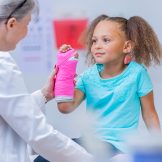
Kids have accidents; that’s just a given. They’re natural daredevils, afraid of nothing. Unfortunately, as much as we’d love to protect our kids from the dangers of contact sports, jungle gym mishaps, or a bad case of roughhousing with the siblings, accidents happen, and small children are prone to injuries. When you’re little one breaks a bone, parents need to be extra careful to keep children safe and clean during the healing process.
Developing bones in young children are more pliable than adult bones, but fractures are fairly common. Caring for children with broken bones can be challenging, especially when they are too young to understand.
The First 48 Hours: How to Care for a Child with a Cast
Once the chaos following a broken bone subsides, and you take your baby home in his or her brand new cast, there are a few things you need to know. Under the cast, the arm or leg is still tender and may be swollen. If your child is too young to understand their injury or what to do on their own, prepare to spend plenty of time snuggling while you also keep the limb elevated and the child distracted.
- Keep the limb elevated above the heart to improve circulation and prevent fluid buildup during the first few days. Prop the injured arm or leg up with pillows and keep an eye on fingers or toes for swelling.
- For the next 48 hours, put an ice pack wrapped in a towel on top of the cast over the injury and replace it often to help reduce the swelling.
- Most children can take OTC child-strength Ibuprofen or acetaminophen for the pain, but be sure to check with your doctor before giving them anything.
Cast Care: How to Care for a Child’s Cast While Healing
There are a variety of cast options today in addition to the traditional plaster casts. Plaster casts can’t get wet, but some of the new materials are water-resistant—not necessarily waterproof. Ask your doctor whether your child’s cast can get wet and how wet it can get. You may need to opt for sponge baths over total immersion. You can buy plastic cast covers that seal above the cast, but they won’t be waterproof enough for immersion, and you want to avoid getting the inside of the cast damp.
Under the cast, the skin tends to get itchy. Very young kids may not be able to communicate the itchy feeling verbally, but you’ll see the signs of discomfort. It may help to use a blow dryer on the cool setting to dry the skin oils and sweat accumulating under there.
They will be tempted, but don’t let your child put anything inside the cast. It’s too easy to scratch the skin and cause an infection.
If your child has a sling, take it off before bedtime. The straps can wrap around the child’s neck and pose a choking hazard.
How to Know If You Need to Call an Orthopedic Specialist
In most cases, you’ll only need to go back to your doctor for scheduled follow-ups, but there are a few warning signs to look out for. First, call your doctor immediately if:
- Your child’s pain increases.
- Your child puts something inside the cast.
- The cast cracks or feels soft or loose.
- Your child’s toes or fingers swell or change color to pale or blue.
- A foul smell comes from inside the cast.
- Pus or fluids ooze out of the cast.
Your doctor will ask you to come in immediately. Your child may have a skin infection or swelling inside the cast, or the cast may need to be replaced.
Post-Cast Care for Kids with Broken Bones
What a relief when the cast comes off and you see that healthy little limb! It will likely smell, but that’s normal. Your little one’s skin will be dry and itchy. A soothing bath in warm, soapy water followed by a moisturizer made for sensitive skin (no dyes or perfumes) will make the skin soft and relieve the itch.
Remember, the cast may be off, but your child is still healing. Your doctor will probably recommend that they take it easy for up to six weeks after the cast is removed. The joints may be stiff and sore, and the limb may be weak. To help them heal, make sure your child avoids strenuous activities like climbing or trike-riding.
The most important thing you can do when caring for a child with a broken bone is to provide love, reassurance, and entertainment. Kids are active, and it will be hard to keep them comfortable and happy with a limb elevated. So be ready with books, games, songs, puzzles, and other non-stressful activities. You know your child better than anyone else. It may take patience and constant vigilance, but it’s prime bonding time with your baby.
Children Require Special Care: MOSH Can Help
At MOSH, we believe that children with broken bones deserve top-quality care in a facility designed just for them. Our orthopedic care team consists of doctors, nurses, and physical and occupational therapists trained to work with kids. When you schedule an appointment with us, you can be confident that your little one will receive the very best care delivered in a kind and compassionate manner.